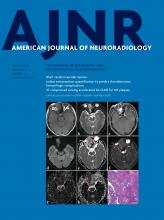Table of Contents
Perspectives
Review Article
General Contents
- High Signal Intensity in the Dentate Nucleus and Globus Pallidus on Unenhanced T1-Weighted MR Images: Comparison between Gadobutrol and Linear Gadolinium-Based Contrast Agents
This is a retrospective analysis of 59 patients who received only gadobutrol and 60 patients who received only linear gadolinium-based contrast agents. Linear gadolinium-based contrast agents included gadoversetamide, gadobenatedimeglumine, and gadodiamide. T1 signal intensity in the globus pallidus, dentate nucleus, and pons was measured on the precontrast portions of patients' first and seventh brain MRIs. The dentate nucleus/pons signal ratio increased in the linear gadolinium-based contrast agent group while no significant increase was seen in the gadobutrol group. The authors conclude that successive doses of gadobutrol do not result in T1 shortening compared with changes seen in linear gadolinium-based contrast agents.
- Iodine Extravasation Quantification on Dual-Energy CT of the Brain Performed after Mechanical Thrombectomy for Acute Ischemic Stroke Can Predict Hemorrhagic Complications
Eighty-five consecutive patients who underwent brain dual-energy CT immediately after mechanical thrombectomy for acute ischemic stroke between August 2013 and January 2017 were included. Two radiologists independently evaluated dual-energy CT images for the presence of parenchymal hyperdensity, iodine extravasation, and hemorrhage. Thirteen of 85 patients developed hemorrhage. On postoperative dual-energy CT, parenchymal hyperdensities and iodine extravasation were present in 100% of the patients who developed intracerebral hemorrhage and in 56.3% of the patients who did not. Median maximum iodine concentration was 2.63 mg/mL in the patients who developed intracerebral hemorrhage and 1.4 mg/mL in the patients who did not. The authors conclude that the presence of parenchymal hyperdensity with a maximum iodine concentration of greater than 1.35 mg/mL may identify patients developing intracerebral hemorrhage with 100% sensitivity and 67.6% specificity.
- Accuracy of the Compressed Sensing Accelerated 3D-FLAIR Sequence for the Detection of MS Plaques at 3T
Twenty-three patients with relapsing-remitting MS underwent both conventional 3D-FLAIR and compressed sensing 3D-FLAIR on a 3T scanner (reduction in scan time 1 minute 25 seconds, 27%; compressed sensing factor of 1.3). Two blinded readers independently evaluated both conventional and compressed sensing FLAIR for image quality and the number of MS lesions visible in the periventricular, intra-juxtacortical, infratentorial, and optic nerve regions. Image quality and the number of MS lesions detected by the readers were similar between the 2 FLAIR acquisitions. Almost perfect agreement was found between the two FLAIR acquisitions for total MS lesion count. The authors conclude that at 3T, and with a compressed sensing factor of 1.3, 3D-FLAIR is 27% faster and preserves diagnostic performance for the detection of MS plaques.
- Endovascular Thrombectomy in Wake-Up Stroke and Stroke with Unknown Symptom Onset
The authors evaluated 1073 patients with anterior circulation stroke undergoing mechanical thrombectomy between 2010 and 2016. Patients with wake-up stroke and daytime-unwitnessed stroke were compared with controls receiving mechanical thrombectomy as the standard of care. There was no significant difference in good functional outcome between patients with wake-up stroke and controls. Outcome in patients with daytime-unwitnessed stroke was inferior compared with controls. Groups did not differ in all-cause mortality at day 90 and the rate of symptomatic intracranial hemorrhage. They conclude that mechanical thrombectomy in selected patients with wake-up stroke allows a good functional outcome comparable with that of controls.
- Intravoxel Incoherent Motion MR Imaging in the Differentiation of Benign and Malignant Sinonasal Lesions: Comparison with Conventional Diffusion-Weighted MR Imaging
One hundred thirty-one patients with histologically proved solid sinonasal lesions (56 benign and 75 malignant) who underwent conventional DWI and intravoxel incoherent motion were evaluated. The diffusion coefficient (D), pseudodiffusion coefficient (D*), and perfusion fraction (f) values derived from intravoxel incoherent motion and ADC values derived from conventional DWI were measured and compared. The mean ADC and D values were significantly lower in malignant sinonasal lesions than in benign sinonasal lesions and the mean f value was higher in malignant than in benign lesions. Multiparametric models can significantly improve the cross-validated areas under the curve for the differentiation of sinonasal lesions compared with single-parametric models. The authors conclude that intravoxel incoherent motion appears to be a more effective MR imaging technique than conventional DWI in the differentiation of benign and malignant sinonasal lesions.
- Multiparametric Analysis of Permeability and ADC Histogram Metrics for Classification of Pediatric Brain Tumors by Tumor Grade
DTI and dynamic contrast-enhanced MR imaging using T1-mapping with flip angles of 2°, 5°, 10°, and 15°, followed by a 0.1-mmol/kg body weight gadolinium-based bolus was performed on 41 patients in addition to standard MR imaging. Permeability data were processed and transfer constant from the blood plasma into the extracellular extravascular space, rate constant from the extracellular extravascular space back into blood plasma, extracellular extravascular volume fraction, and fractional blood plasma volume were calculated from 3D tumor volumes. Apparent diffusion coefficient histogram metrics were calculated. Wilcoxon tests showed a higher transfer constant from blood plasma into extracellular extravascular space and rate constant from extracellular extravascular space back into blood plasma, and lower extracellular extravascular volume fraction in high-grade tumors. The mean ADCs of FLAIR and enhancing tumor volumes were significantly lower in high-grade tumors. The authors conclude that ADC histogram metrics combined with permeability metrics differentiate low- and high-grade pediatric brain tumors with high accuracy.








